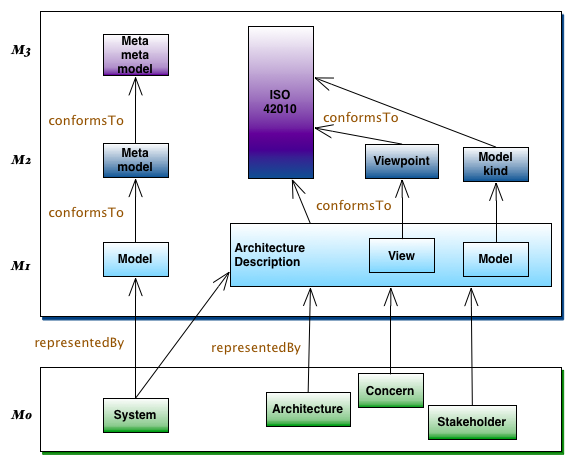Model and Meta Model Matters
Since the initial publication of IEEE 1471:2000, the Standard has
been built upon a conceptual model, often called a “meta model,”
of the terms and concepts pertaining to Architecture
Description.
The current version is described here.
(For historical perspective,
here
is the version as it appeared
in the first edition, IEEE 1471-2000™.)
ISO/IEC/IEEE 42010:2011 also established a specific requirement on architecture frameworks claiming conformance to the Standard that referred to the conceptual (or meta) model:
An architecture framework shall establish its consistency with the provisions of the conceptual model.
For discussion of that requirement and how various architecture frameworks (MODAF, DODAF, NAF, TRAK, TOGAF) use meta models, see [Hilliard, 2011].
Jean Bézivin’s “On the Unification Power of Models” [preprint] offers a useful way of thinking about these matters. The diagram below uses Bézivin’s 3+1 MDA scheme from that paper to “sort out” the concepts in the Standard.

The left-hand side of the diagram depicts Bézivin’s original scheme. The right-hand side shows where ISO/IEC/IEEE 42010’s constructs align with the levels.
Level M0, the green level, depicts the real world of Systems, Architectures, their Stakeholders and Concerns.
Level M1, the light blue level, is the world of models. Models represent things in the real world. Architecture Descriptions are models, consisting of other models: (Architecture) Views and (Architecture) Models, which represent Architectures. Level M1 is distinct from M0, as in the slogan: The map is not the territory. This distinction is useful to remember when talking to folks who confuse Architectures and Architecture Descriptions (or do not use the latter term at all).
Level M2 captures the conventions, or rules, that models on the M1 level conform, or adhere, to. This is the world of meta models. In the Standard, (Architecture) Viewpoints and Model Kinds are found at this level. Level M2 is distinct from M1; here the slogan could be: The map is not the legend. Often, the terms view and viewpoint are used interchangeably, or by folks who do not understand the difference. This explains that difference: viewpoints provide the conventions, the “legends,” for views.
Level M3 is the world of meta meta models, where the rules for expressing conventions on models are located. Note that the Standard spans M2 and M3: it specifies both conventions on Architecture Descriptions, and conventions on specifying Viewpoints and Model Kinds (not shown: architecture frameworks and architecture description languages).
See also: How to Build, Implement, and Use an Architecture Metamodel.
Resources for the ISO/IEC/IEEE 42010 website provided by Olimpia.com. Comments, corrections, suggestions on this site to: Webmaster.